Prospective, Randomized, Comparative Study of Myeloablative Fludarabine/Busulfan and Fludarabine/Busulfan/Total Body Irradiation Conditioning in Myeloid Diseases
Simple Summary
Abstract
1. Introduction
2. Materials and Methods
2.1. Treatment
2.2. Definition of Relapse
2.3. Definition of Graft-Versus-Host Disease (GvHD)
2.4. Statistical Analysis
3. Results
3.1. Patient Characteristics
3.2. Relapse
3.3. Survival
3.4. Non-Relapse Mortality
3.5. Development of GvHD
4. Discussion
5. Conclusions
Author Contributions
Funding
Institutional Review Board Statement
Informed Consent Statement
Data Availability Statement
Conflicts of Interest
Abbreviations
| ABW | Actual body weight |
| aGvHD | Acute graft-versus-host disease |
| AlloSCT | Allogeneic hematopoietic stem cell transplantation |
| AML | Acute myeloid leukemia |
| ANC | Absolute neutrophil count |
| BM | Bone marrow |
| cGvHD | Chronic graft-versus-host disease |
| CIR | Cumulative incidence of relapse |
| CML | Chronic myeloid leukemia |
| CML-BC | Chronic myeloid leukemia (blast crisis) |
| CMML | Chronic myelomonocytic leukemia |
| CMV | Cytomegalovirus |
| CR1 | First complete remission |
| CR2 | Second complete remission |
| Cy | Cyclophosphamide |
| ELN | European LeukemiaNet |
| EFS | Event-free survival |
| Flu/Bu | Fludarabine/busulfan |
| Flu/Bu4 | Sequential 4-day regimen of fludarabine/busulfan |
| G-CSF | Granulocyte colony-stimulating factor |
| GvHD | Graft-versus-host disease |
| GVL | Graft-versus-leukemia |
| HCT-CI | Hematopoietic Stem Cell Transplant Comorbidity Index |
| HLA | Human leukocyte antigen |
| HSC | Hematopoietic stem cells |
| IBW | Ideal body weight |
| IQR | Interquartile range |
| IRB | Institutional Review Board |
| MAC | Myeloablative conditioning |
| MDS | Myelodysplastic syndrome |
| MF | Myelofibrosis |
| MRD | Minimal residual disease |
| MTX | Methotrexate |
| NGS | Next-generation sequencing |
| NRM | Non-relapse mortality |
| OS | Overall survival |
| PB | Peripheral blood |
| PBSC | Peripheral blood stem cells |
| PJP | Pneumocystis jirovecii pneumonia |
| rATG | Rabbit anti-thymocyte globulin |
| RIC | Reduced-intensity conditioning |
| Tac | Tacrolimus |
| TBI | Total body irradiation |
| TRM | Transplant-related mortality |
| URD | Unrelated donors |
Appendix A
Description of Supportive Care
References
- Cooper, J.P.; Storer, B.E.; Granot, N.; Gyurkocza, B.; Sorror, M.L.; Chauncey, T.R.; Shizuru, J.; Franke, G.-N.; Maris, M.B.; Boyer, M.; et al. Allogeneic hematopoietic cell transplantation with non-myeloablative conditioning for patients with hematologic malignancies: Improved outcomes over two decades. Haematologica 2021, 106, 1599–1607. [Google Scholar] [PubMed]
- Lipof, J.J.; Loh, K.P.; O’Dwyer, K.; Liesveld, J.L. Allogeneic hematopoietic cell transplantation for older adults with acute myeloid leukemia. Cancers 2018, 10, 179. [Google Scholar] [CrossRef] [PubMed]
- Jethava, Y.S.; Sica, S.; Savani, B.; Socola, F.; Jagasia, M.; Mohty, M.; Nagler, A.; Bacigalupo, A. Conditioning regimens for allogeneic hematopoietic stem cell transplants in acute myeloid leukemia. Bone Marrow Transplant. 2017, 52, 1504–1511. [Google Scholar] [PubMed]
- Leonard, J.T.; Hayes-Lattin, B. Reduced intensity conditioning allogeneic hematopoietic stem cell transplantation for acute lymphoblastic leukemia; current evidence, and improving outcomes going forward. Curr. Hematol. Malig. Rep. 2018, 13, 329–340. [Google Scholar]
- Sengsayadeth, S.; Savani, B.N.; Blaise, D.; Malard, F.; Nagler, A.; Mohty, M. Reduced intensity conditioning allogeneic hematopoietic cell transplantation for adult acute myeloid leukemia in complete remission—A review from the Acute Leukemia Working Party of the EBMT. Haematologica 2015, 100, 859–869. [Google Scholar]
- Bolon, Y.T.; Atshan, A.R.; Allbee-Johnson, M.; Estrada-Merly, N.; Lee, S.J. Current Uses and Outcomes of Hematopoietic Stem Cell Transplantation in the U.S. Available online: https://cibmtr.org/CIBMTR/Resources/Summary-Slides-Reports (accessed on 20 February 2025).
- Craddock, C.; Jackson, A.; Loke, J.; Siddique, S.; Hodgkinson, A.; Mason, J.; Andrew, G.; Nagra, S.; Malladi, R.; Peniket, A.; et al. Augmented reduced-intensity regimen does not improve postallogeneic transplant outcomes in acute myeloid leukemia. J. Clin. Oncol. 2021, 39, 768–778. [Google Scholar]
- Scott, B.L.; Pasquini, M.C.; Logan, B.R.; Wu, J.; Devine, S.M.; Porter, D.L.; Maziarz, R.T.; Warlick, E.D.; Fernandez, H.F.; Alyea, E.P.; et al. Myeloablative versus reduced-intensity hematopoietic cell transplantation for acute myeloid leukemia and myelodysplastic syndromes. J. Clin. Oncol. 2017, 35, 1154–1161. [Google Scholar]
- Scott, B.L.; Pasquini, M.C.; Fei, M.; Fraser, R.; Wu, J.; Devine, S.M.; Porter, D.L.; Maziarz, R.T.; Warlick, E.; Fernandez, H.F.; et al. Myeloablative versus reduced-intensity conditioning for hematopoietic cell transplantation in acute myelogenous leukemia and myelodysplastic syndromes–long-term follow-up of the BMT CTN 0901 clinical trial. Transplant. Cell. Ther. 2021, 27, 483.e1–483.e6. [Google Scholar]
- Bieri, S.; Helg, C.; Chapuis, B.; Miralbell, R. Total body irradiation before allogeneic bone marrow transplantation: Is more dose better? Int. J. Radiat. Oncol. Biol. Phys. 2001, 49, 1071–1077. [Google Scholar]
- Clift, R.A.; Buckner, C.D.; Appelbaum, F.R.; Bearman, S.I.; Petersen, F.B.; Fisher, L.D.; Anasetti, C.; Beatty, P.; Bensinger, W.I.; Doney, K.; et al. Allogeneic marrow transplantation in patients with acute myeloid leukemia in first remission: A randomized trial of two irradiation regimens. Blood 1990, 76, 1867–1871. [Google Scholar] [CrossRef]
- Sabloff, M.; Chhabra, S.; Wang, T.; Fretham, C.; Kekre, N.; Abraham, A.; Adekola, K.; Auletta, J.J.; Barker, C.; Beitinjaneh, A.M.; et al. Comparison of high doses of total body irradiation in myeloablative conditioning before hematopoietic cell transplantation. Biol. Blood Marrow Transplant. 2019, 25, 2398–2407. [Google Scholar] [CrossRef] [PubMed]
- Kebriaei, P.; Anasetti, C.; Zhang, M.-J.; Wang, H.-L.; Aldoss, I.; de Lima, M.; Khoury, H.J.; Sandmaier, B.M.; Horowitz, M.M.; Artz, A.; et al. Intravenous busulfan compared with total body irradiation pretransplant conditioning for adults with acute lymphoblastic leukemia. Biol. Blood Marrow Transplant. 2018, 24, 726–733. [Google Scholar] [CrossRef] [PubMed]
- Santos, G.W.; Tutschka, P.J.; Brookmeyer, R.; Saral, R.; Beschorner, W.E.; Bias, W.B.; Braine, H.G.; Burns, W.H.; Elfenbein, G.J.; Kaizer, H.; et al. Marrow transplantation for acute nonlymphocytic leukemia after treatment with busulfan and cyclophosphamide. N. Engl. J. Med. 1983, 309, 1347–1353. [Google Scholar] [CrossRef]
- Lindley, C.; Shea, T.; McCune, J.; Shord, S.; Decker, J.; Harvey, D.; Petros, W.P.; Garbriel, D.; Serody, J.; Kirby, S.; et al. Intraindividual variability in busulfan pharmacokinetics in patients undergoing a bone marrow transplant: Assessment of a test dose and first dose strategy. Anticancer Drugs 2004, 15, 453–459. [Google Scholar] [CrossRef]
- Shimoni, A.; Bielorai, B.; Toren, A.; Hardan, I.; Avigdor, A.; Yeshurun, M.; Ben-Bassat, I.; Nagler, A. Intravenous busulfan-based conditioning prior to allogeneic hematopoietic stem cell transplantation: Myeloablation with reduced toxicity. Exp. Hematol. 2003, 31, 428–434. [Google Scholar] [CrossRef]
- Liu, H.; Zhai, X.; Song, Z.; Sun, J.; Xiao, Y.; Nie, D.; Zhang, Y.; Huang, F.; Zhou, H.; Fan, Z.; et al. Busulfan plus fludarabine as a myeloablative conditioning regimen compared with busulfan plus cyclophosphamide for acute myeloid leukemia in first complete remission undergoing allogeneic hematopoietic stem cell transplantation: A prospective and multicenter study. J. Hematol. Oncol. 2013, 6, 15. [Google Scholar]
- Russell, J.A.; Irish, W.; Balogh, A.; Chaudhry, M.A.; Savoie, M.L.; Turner, A.R.; Larratt, L.; Storek, J.; Bahlis, N.J.; Brown, C.B.; et al. The addition of 400 cGY total body irradiation to a regimen incorporating once-daily intravenous busulfan, fludarabine, and antithymocyte globulin reduces relapse without affecting nonrelapse mortality in acute myelogenous leukemia. Biol. Blood Marrow Transplant. 2010, 16, 509–514. [Google Scholar] [CrossRef]
- Harris, A.C.; Young, R.; Devine, S.; Hogan, W.J.; Ayuk, F.; Bunworasate, U.; Chanswangphuwana, C.; Efebera, Y.A.; Holler, E.; Litzow, M.; et al. International, multicenter standardization of acute graft-versus-host disease clinical data collection: A report from the Mount Sinai Acute GVHD International Consortium. Biol. Blood Marrow Transplant. 2016, 22, 4–10. [Google Scholar] [CrossRef]
- Pavletic, S.Z.; Vogelsang, G.B.; Lee, S.J. 2014 National Institutes of Health consensus development project on criteria for clinical trials in chronic graft-versus-host disease: Preface to the series. Biol. Blood Marrow Transplant. 2015, 21, 387–388. [Google Scholar] [CrossRef]
- Döhner, H.; Estey, E.; Grimwade, D.; Amadori, S.; Appelbaum, F.R.; Büchner, T.; Dombret, H.; Ebert, B.L.; Fenaux, P.; Larson, R.A.; et al. Diagnosis and management of AML in adults: 2017 ELN recommendations from an international expert panel. Blood 2017, 129, 424–447. [Google Scholar] [CrossRef]
- Sorror, M.L.; Maris, M.B.; Storb, R.; Baron, F.; Sandmaier, B.M.; Maloney, D.G.; Storer, B. Hematopoietic cell transplantation (HCT)-specific comorbidity index: A new tool for risk assessment before allogeneic HCT. Blood 2005, 106, 2912–2919. [Google Scholar] [CrossRef] [PubMed]
- De La Serna, J.; Sanz, J.; Bermudez, A.; Cabrero, M.; Serrano, D.; Vallejo, C.; Gómez, V.; Moraleda, J.M.; Perez, S.G.; Caballero, M.D.; et al. Toxicity and efficacy of busulfan and fludarabine myeloablative conditioning for HLA-identical sibling allogeneic hematopoietic cell transplantation in AML and MDS. Bone Marrow Transplant. 2016, 51, 961–966. [Google Scholar] [CrossRef] [PubMed]
- Patel, S.S.; Rybicki, L.; Pohlman, B.; Bolwell, B.; Gerds, A.T.; Hamilton, B.K.; Hanna, R.; Kalaycio, M.; Majhail, N.S.; Sobecks, R. Comparative effectiveness of busulfan/cyclophosphamide versus busulfan/fludarabine myeloablative conditioning for allogeneic hematopoietic cell transplantation in acute myeloid leukemia and myelodysplastic syndrome. Hematol. Oncol. Stem Cell Ther. 2020, 13, 160–165. [Google Scholar] [CrossRef]
- Andersson, B.S.; Thall, P.F.; Ma, J.; Valdez, B.C.; Bassett, R., Jr.; Chen, J.; Ahmed, S.; Alousi, A.; Bashir, Q.; Ciurea, S.; et al. A randomized phase III study of pretransplant conditioning for AML/MDS with fludarabine and once daily IV busulfan +/− clofarabine in allogeneic stem cell transplantation. Bone Marrow Transplant. 2022, 57, 1295–1303. [Google Scholar]
- Deeg, H.J.; Stevens, E.A.; Salit, R.B.; Ermoian, R.P.; Fang, M.; Gyurkocza, B.; Sorror, M.L.; Fatobene, G.; Baumgart, J.; Burroughs, L.M.; et al. Transplant conditioning with treosulfan/fludarabine with or without total body irradiation: A randomized phase II trial in patients with myelodysplastic syndrome and acute myeloid leukemia. Biol. Blood Marrow Transplant. 2018, 24, 956–963. [Google Scholar]
- Baker, K.S.; Leisenring, W.M.; Goodman, P.J.; Ermoian, R.P.; Flowers, M.E.; Schoch, G.; Storb, R.; Sandmaier, B.M.; Deeg, H.J. Total body irradiation dose and risk of subsequent neoplasms following allogeneic hematopoietic cell transplantation. Blood 2019, 133, 2790–2799. [Google Scholar]
- Nunez, L.; Abedin, T.; Naqvi, S.; Shen, H.; Chaudhry, A.; Bellerby, S.; Savoie, L.; Daly, A.; Shafey, M.; Duggan, P.; et al. Cumulative incidence of subsequent malignancy after allo-HCT conditioned with or without low-dose total body irradiation. Blood Adv. 2022, 6, 767–773. [Google Scholar] [CrossRef]
- Russell, J.A.; Kangarloo, S.B.; Williamson, T.; Chaudhry, M.A.; Savoie, M.L.; Turner, A.R.; Larratt, L.; Storek, J.; Bahlis, N.J.; Shafey, M.; et al. Establishing a target exposure for once-daily intravenous busulfan given with fludarabine and thymoglobulin before allogeneic transplantation. Biol. Blood Marrow Transplant. 2013, 19, 1381–1386. [Google Scholar] [CrossRef]
- Ousia, S.; Kalra, A.; Williamson, T.S.; Prokopishyn, N.; Dharmani-Khan, P.; Khan, F.M.; Jimenez-Zepeda, V.; Jamani, K.; Duggan, P.R.; Daly, A.; et al. Hematopoietic cell transplant outcomes after myeloablative conditioning with fludarabine, busulfan, low-dose total body irradiation, and rabbit antithymocyte globulin. Clin. Transplant. 2020, 34, e14018. [Google Scholar] [CrossRef]
- Buckley, S.A.; Wood, B.L.; Othus, M.; Hourigan, C.S.; Ustun, C.; Linden, M.A.; DeFor, T.E.; Malagola, M.; Anthias, C.; Valkova, V.; et al. Minimal residual disease prior to allogeneic hematopoietic cell transplantation in acute myeloid leukemia: A meta-analysis. Haematologica 2017, 102, 865–873. [Google Scholar]
- Short, N.J.; Zhou, S.; Fu, C.; Berry, D.A.; Walter, R.B.; Freeman, S.D.; Hourigan, C.S.; Huang, X.; Nogueras Gonzalez, G.; Hwang, H.; et al. Association of measurable residual disease With survival outcomes in patients with acute myeloid leukemia: A systematic review and meta-analysis. JAMA Oncol. 2020, 6, 1890–1899. [Google Scholar] [PubMed]
- Araki, D.; Wood, B.L.; Othus, M.; Radich, J.P.; Halpern, A.B.; Zhou, Y.; Mielcarek, M.; Estey, E.H.; Appelbaum, F.R.; Walter, R.B. Allogeneic hematopoietic cell transplantation for acute myeloid leukemia: Time to move toward a minimal residual disease-based definition of complete remission? J. Clin. Oncol. 2016, 34, 329–336. [Google Scholar] [PubMed]
- Morsink, L.M.; Sandmaier, B.M.; Othus, M.; Palmieri, R.; Granot, N.; Bezerra, E.D.; Wood, B.L.; Mielcarek, M.; Schoch, G.; Davis, C.; et al. Conditioning intensity, pre-transplant flow cytometric measurable residual disease, and outcome in adults with acute myeloid leukemia undergoing allogeneic hematopoietic cell transplantation. Cancers 2020, 12, 2339. [Google Scholar] [CrossRef] [PubMed]
- Simoes, C.; Paiva, B.; Martinez-Cuadrón, D.; Bergua, J.-M.; Vives, S.; Algarra, L.; Tormo, M.; Martinez, P.; Serrano, J.; Herrera, P.; et al. Measurable residual disease in elderly acute myeloid leukemia: Results from the PETHEMA-FLUGAZA phase 3 clinical trial. Blood Adv. 2021, 5, 760–770. [Google Scholar]
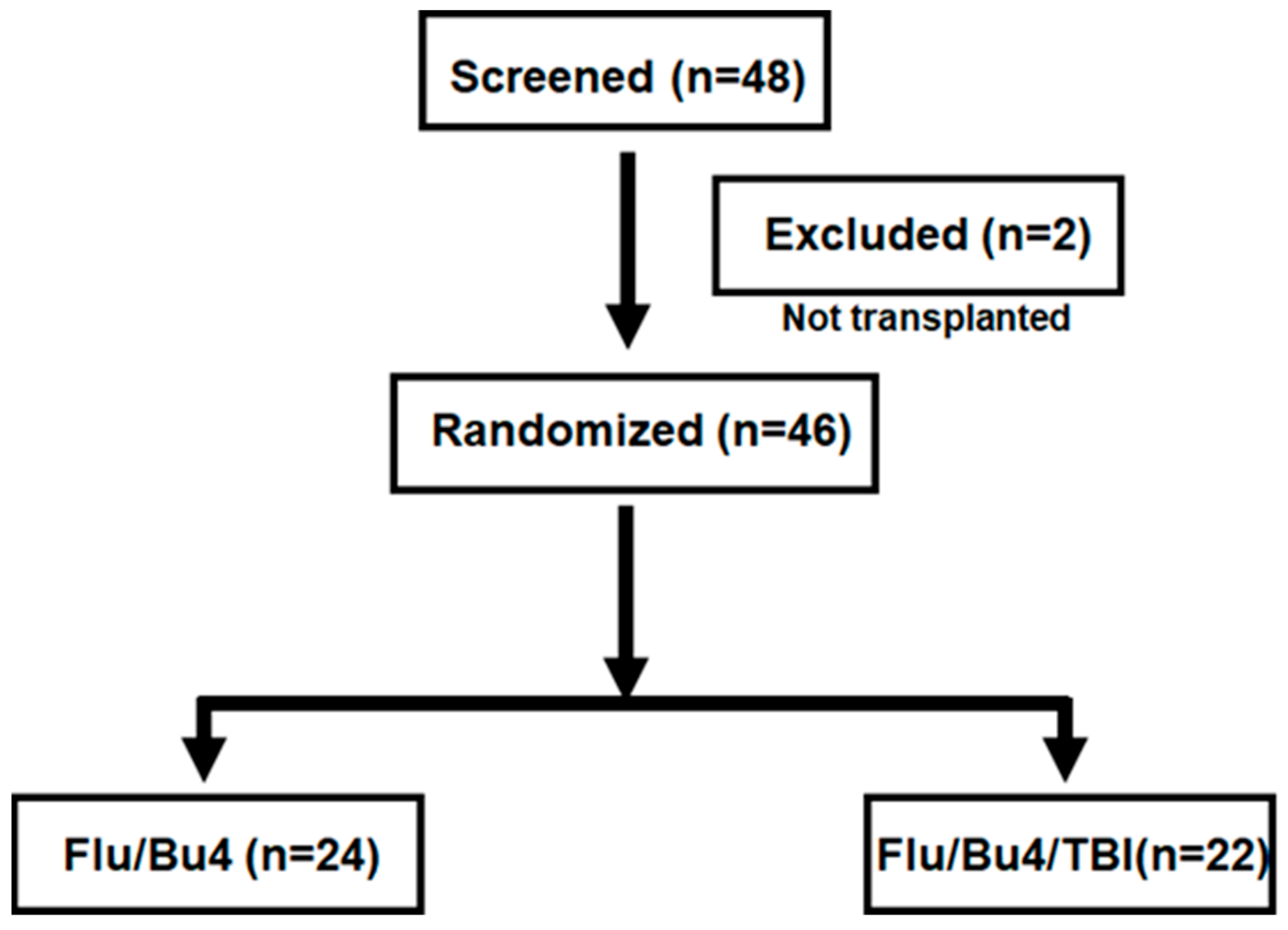
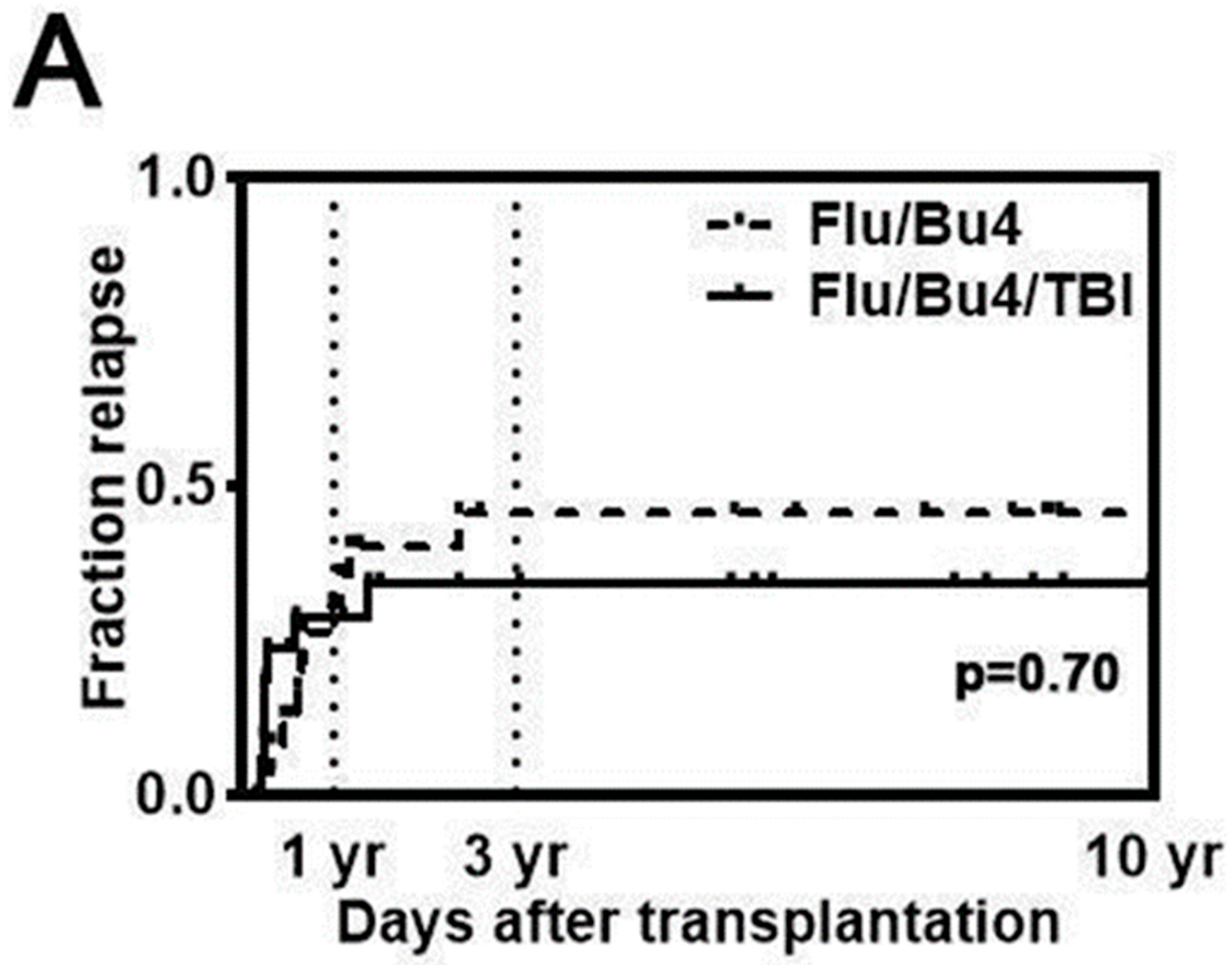
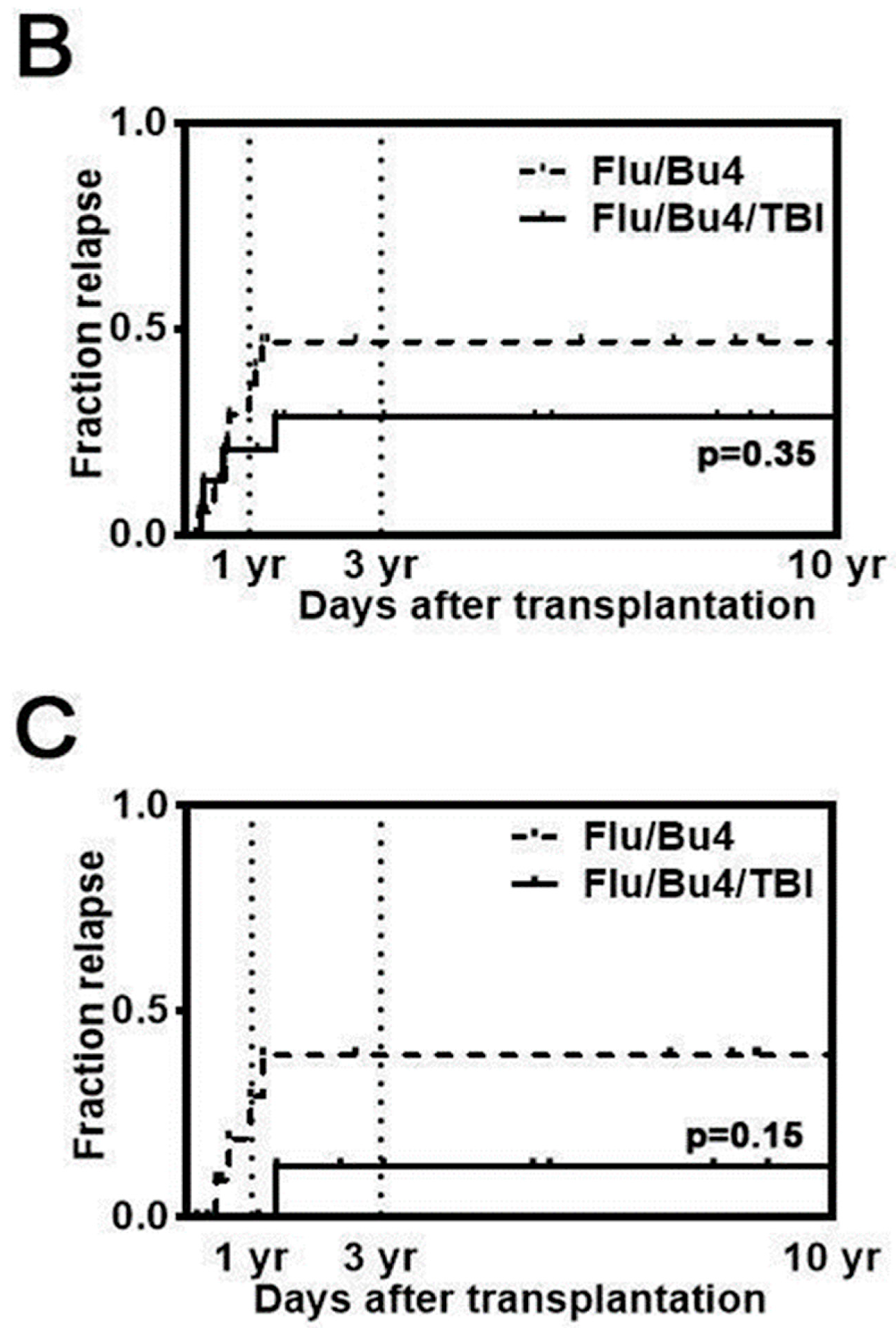
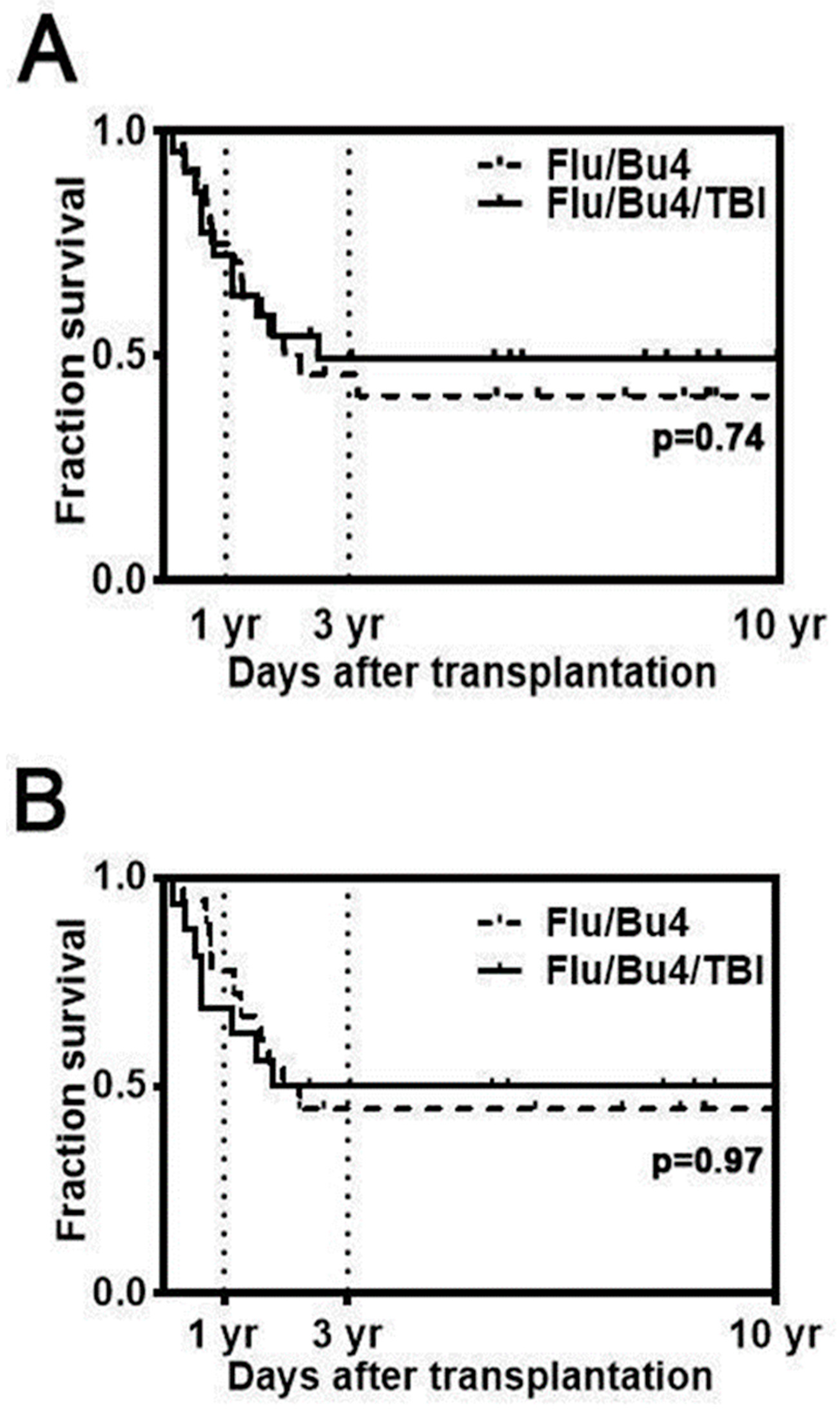
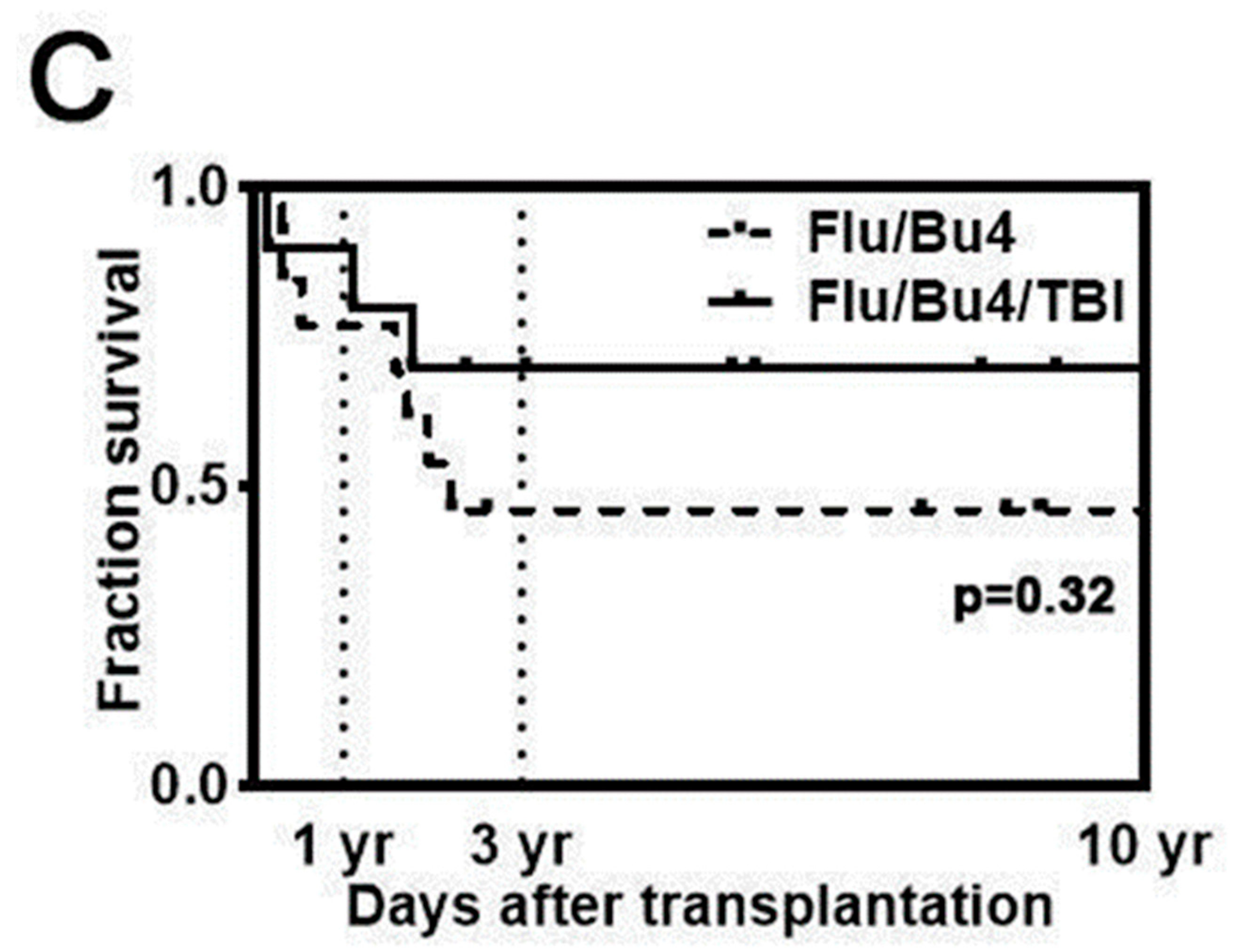
| Variable | Flu/Bu4 (n = 24) Count (%) | Flu/Bu4/TBI (n = 22) Count (%) | p-Value |
|---|---|---|---|
| Age, years | 0.91 | ||
| Median (IQR) | 49.0 (40.5–60.5) | 53.0 (42.0–58.0) | |
| Range (Min–Max) | 25.0–62.0 | 22.0–63.0 | |
| Sex | 0.96 | ||
| Female | 10 (41.7) | 9 (40.9) | |
| Male | 14 (58.3) | 13 (59.1) | |
| HCT-CI 1 | 0.49 | ||
| 0–2 | 22 (91.7) | 22 (100) | |
| ≥3 | 2 (8.3) | 0 (0) | |
| Diagnosis | 0.89 | ||
| AML | 18 (75.0) | 16 (72.7) | |
| Favorable risk | 5 (27.8) | 0 (0) | 0.06 |
| Intermediate risk | 4 (22.2) | 3 (18.8) | |
| Adverse risk | 9 (50.0) | 13 (81.2) | |
| CR status | 1.00 | ||
| CR1 | 13 (72.2) | 11 (68.6) | |
| CR2 | 5 (27.8) | 5 (31.2) | |
| MDS | 3 (12.5) | 2 (9.1) | |
| MF | 1 (4.2) | 2 (9.1) | |
| CML-BC | 0 (0) | 1 (4.6) | |
| CMML | 2 (8.3) | 1 (4.6) |
| Variable | Flu/Bu4 (n = 24) Count (%) | Flu/Bu4/TBI (n = 22) Count (%) | p-Value |
|---|---|---|---|
| Donor | 0.23 | ||
| Sibling, identical | 9 (37.5) | 4 (18.2) | |
| Unrelated | |||
| HLA matched | 13 (54.2) | 13 (59.1) | |
| HLA mismatched | 2 (8.3) | 5 (22.7) | |
| Donor/Recipient Sex | 0.20 | ||
| Male to Male | 10 (41.7) | 9 (40.9) | |
| Male to Female | 4 (16.7) | 8 (36.3) | |
| Female to Male | 4 (16.7) | 4 (18.2) | |
| Female to Female | 6 (25.0) | 1 (4.6) | |
| Stem cell source | 0.41 | ||
| PBSCs | 22 (91.7) | 18 (81.8) | |
| BM | 2 (8.3) | 4 (18.2) | |
| GvHD prophylaxis | |||
| Tac/MTX | 24 (100) | 22 (100) | |
| CMV status | 0.37 | ||
| Donor+ to Recipient+ | 8 (33.3) | 6 (27.3) | |
| Donor+ to Recipient− | 1 (4.2) | 5 (22.7) | |
| Donor− to Recipient+ | 8 (33.3) | 6 (27.3) | |
| Donor− to Recipient− | 7 (29.2) | 5 (22.7) | |
| Time to engraftment | |||
| Neutrophil (days) | |||
| Median (IQR) | 13.0 (12.0–15.0) | 13.0 (12.0–14.0) | |
| Range (Min–Max) | 11.0–23.0 | 10.0–20.0 | |
| Platelet (days) | |||
| Median (IQR) | 12.0 (10.0–15.0) | 13.0 (12.0–18.0) | |
| Range (Min–Max) | 10.0–21.0 | 9.0–20.0 |
| Variable | Flu/Bu4 Count (%) | Flu/Bu4/TBI Count (%) |
|---|---|---|
| Relapse | 7 (53.8) | 5 (45.4) |
| GvHD | 1 (7.7) | 2 (18.2) |
| Organ failure | 1 (7.7) | 2 (18.2) |
| Infection | 2 (15.4) | 2 (18.2) |
| Other cancer | 1 (7.7) | 0 (0) |
| Accident | 1 (7.7) | 0 (0) |
| Variable | Flu/Bu4 Count (%) | Flu/Bu4/TBI Count (%) | p-Value |
|---|---|---|---|
| Acute GvHD | |||
| Grade II–IV | 7 (29.2) | 14 (63.6) | 0.02 |
| Grade ≥ III | 2 (8.3) | 3 (13.6) | 0.66 |
| Chronic GvHD | 0.87 | ||
| Limited | 4 (16.7) | 8 (36.4) | |
| Extensive | 3 (12.5) | 3 (13.6) |
Disclaimer/Publisher’s Note: The statements, opinions and data contained in all publications are solely those of the individual author(s) and contributor(s) and not of MDPI and/or the editor(s). MDPI and/or the editor(s) disclaim responsibility for any injury to people or property resulting from any ideas, methods, instructions or products referred to in the content. |
© 2025 by the authors. Licensee MDPI, Basel, Switzerland. This article is an open access article distributed under the terms and conditions of the Creative Commons Attribution (CC BY) license (https://creativecommons.org/licenses/by/4.0/).
Share and Cite
Suh, H.C.; Rowley, S.D.; Kaur, S.; Lukasik, B.; McKiernan, P.; Boonstra, M.; Baker, M.; DiLorenzo, M.; Skarbnik, A.; Voss, J.; et al. Prospective, Randomized, Comparative Study of Myeloablative Fludarabine/Busulfan and Fludarabine/Busulfan/Total Body Irradiation Conditioning in Myeloid Diseases. Cancers 2025, 17, 1140. https://doi.org/10.3390/cancers17071140
Suh HC, Rowley SD, Kaur S, Lukasik B, McKiernan P, Boonstra M, Baker M, DiLorenzo M, Skarbnik A, Voss J, et al. Prospective, Randomized, Comparative Study of Myeloablative Fludarabine/Busulfan and Fludarabine/Busulfan/Total Body Irradiation Conditioning in Myeloid Diseases. Cancers. 2025; 17(7):1140. https://doi.org/10.3390/cancers17071140
Chicago/Turabian StyleSuh, Hyung C., Scott D. Rowley, Sukhdeep Kaur, Brittany Lukasik, Phyllis McKiernan, Michele Boonstra, Melissa Baker, Mary DiLorenzo, Alan Skarbnik, Jason Voss, and et al. 2025. "Prospective, Randomized, Comparative Study of Myeloablative Fludarabine/Busulfan and Fludarabine/Busulfan/Total Body Irradiation Conditioning in Myeloid Diseases" Cancers 17, no. 7: 1140. https://doi.org/10.3390/cancers17071140
APA StyleSuh, H. C., Rowley, S. D., Kaur, S., Lukasik, B., McKiernan, P., Boonstra, M., Baker, M., DiLorenzo, M., Skarbnik, A., Voss, J., Hampson, A., DeAgresta, B., Boylan, B., Nyirenda, T., Vesole, D. H., & Donato, M. L. (2025). Prospective, Randomized, Comparative Study of Myeloablative Fludarabine/Busulfan and Fludarabine/Busulfan/Total Body Irradiation Conditioning in Myeloid Diseases. Cancers, 17(7), 1140. https://doi.org/10.3390/cancers17071140






